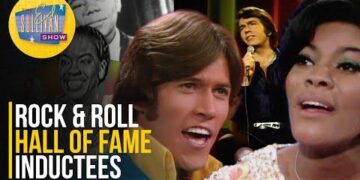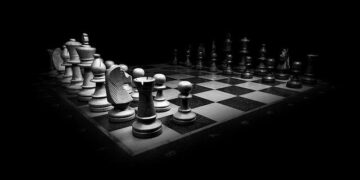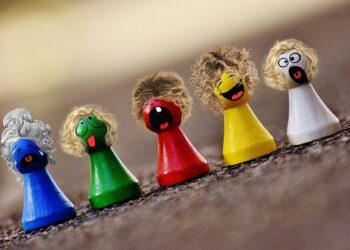We may earn revenue from the products available on this page and participate in affiliate programs. Learn more ›
Binoculars bring everything from birds to planets into view, but finding the right pair means looking first at when and how you plan to use them. Deciding on a budget is also a good idea, as these devices can easily cost well over $2,000. However, you don’t need to take out a loan to see the moon, a sporting event, or wildlife with crystal clarity. The binoculars’ magnification, objective lens size, weight, and lens coatings are only a few of the specs that will affect the optic quality. We’ve got the rundown on the important specs and five recommended pairs of the best binoculars that are more than worth their price.
Best overall: Zeiss Conquest HD Binocular
Best for birdwatching: Maven B1.2 42mm
Best for hunting: Vortex Optics Viper HD Roof Prism Binoculars
Best night vision: JStoon Night Vision Goggles
Best budget: Vortex Optics Crossfire HD Binoculars
How we chose the best binoculars
We evaluated several key specs when considering the best binoculars. Specifically, we looked at the magnification, objective lens size, field of view, and lens coatings. All of these factors ultimately combine to determine the quality.
The magnification and objective lens need to create a balance between viewing quality and field of view so that it’s fairly easy for users to track their desired object. Lens coatings make a big difference in light transmission. We looked for coatings that enhanced the brightness and clarity at the magnification and objective lens size.
Finally, we consider weight and ease of focus. Heavy binoculars can weigh down the neck or may require a tripod for easier viewing. Pairs that are easy to focus allow easier tracking of fast objects like birds or participants in sporting events. For those who are a little active and adventurous, binoculars for hiking can help you track down avian friends and cool trees as you stop at a mountain vista overlooking a lake.
The best binoculars: Reviews & Recommendations
There are many sights to behold with the right pair of binoculars. One of our recommendations should let you view faraway mountains, animals, or even your neighbor’s dog taking an illegal poop in your backyard.
Best overall: Zeiss Conquest HD 8×42 Binocular
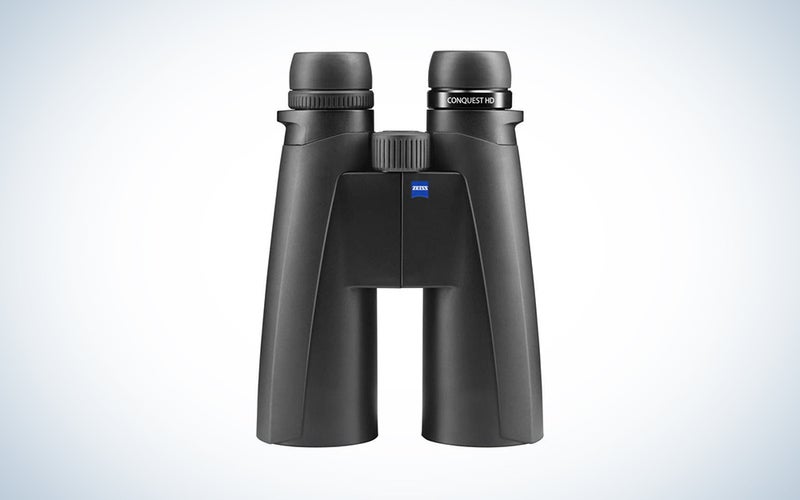
Specs
Weight: 28 ounces
Magnification: 8x
Objective lens: 42 mm
Pros
View 384 feet at 1,000 yards
Lens design and coatings provide bright images
Quick focus
Cons
Interpupillary distance may be too large for some users
This pick from Zeiss combines everything we love in binoculars into a single pair. They’re relatively lightweight at only 28 ounces, so birders and hunters can wear them around their necks without feeling weighed down. The 8×42 size provides the right balance of magnification to the objective lens for a generous field of view that shows 384 feet at 1,000 yards. The high-quality glass lenses transfer 90 percent of light, working beautifully in low-light conditions.
Zeiss uses a LotuTec coating that provides clear views in inclement weather by preventing water from sticking to the lens. Another coating improves the colors and brilliance of images. Birders, in particular, like the quick focus of the center knob, which is designed to jump right into the action for fast-moving objects.
A con to watch out for is the interpupillary distance (the distance between the eyepieces). You may need an extender piece if you have a narrow pupillary distance (distance between the center of your pupils).
Best for birdwatching: Maven B1.2 42mm ED Binoculars
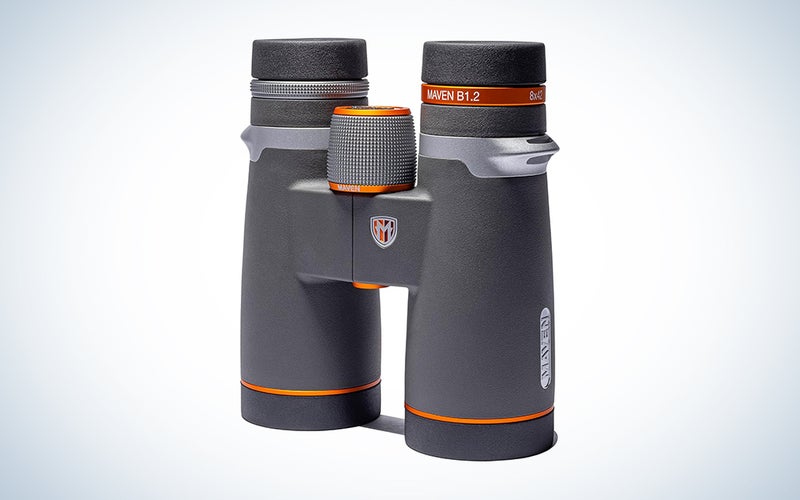
Specs
Weight: 26.8 ounces
Magnification: 10
Objective lens: 42
Pros
Sharp, quick focus
Excellent low-light performance
Small, compact, and easy to carry
Water and fog-proof
Cons
Expensive
The Maven B1.2’s bring quick clarity to the birding world. They’re lightweight at only 26.8 ounces, yet the 10x magnification and 42mm objective lenses provide an excellent field of view. Their field of view is relatively wide for 10×42 binoculars at 388 feet from 1,000 yards.
One of the reasons they’re a great pair of binoculars for bird-watching is the brightness and colors the lenses and coatings create. They reflect as much light as possible so that you see true colors.
The B1.2s also have a sharp, quick focus that can keep up with birds on the move. We also like the small, compact size. You can take them off the beaten trail to catch more unusual birds without feeling weighed down. Finally, they’re water and fog-proof to let you keep gazing even if the weather turns. The downside is that they’re pricey and more of a best splurge type of purchase. If you want to look at your avian friends while on your phone, consider the Bird Buddy Smart Bird Feeder, which lets you take photos of the winged wonders who feast upon the luscious Michelin five-star seed mix in the feeder.
Best for hunting: Vortex Optics Viper HD Roof Prism Binoculars

Specs
Weight: 43 ounces
Magnification: 10x
Objective lens: 42mm
Pros
Clear views of the high-density glass lenses excellent in low-light
Lifetime warranty
Durable rubber casing
Quick, responsive focus
Cons
On the expensive side
The Vortex Optics Viper HD Binoculars bring a lot of great specs together into a highly functional pair of hunting binoculars. They’re not the most powerful, lightest, or high-tech, but they bring those three elements together into a near-perfect balance.
The 8x magnification with the 42mm objective high-density lenses lets in light that keeps images clear, even in low light. The rubber casing gives them added durability for hunters who trudge through rough, steep terrain, too. For those quick glances, the focus snaps into place with single-hand adjustments. That’s all supported by a decent field of view of 319 feet at 1,000 yards. Finally, Vortex offers an impressive lifetime warranty. These are pricey, and that warranty ensures your investment won’t be wasted after a fall or drop out in the field.
Best night vision: JStoon Night Vision Goggles

Specs
Weight: 20.3 ounces
Magnification: 3x (optical), 4x (digital)
Objective lens: 25mm
Pros
2.31-inch screen
Seven infrared adjustment levels
Six hours of recording time
Cons
Limited distance
The JStoon Night Vision Goggles have a 3x optical zoom and 4x digital zoom. They’re among the best night vision goggles for the money. The lenses project an image onto a 2.31-inch digital screen, where you can adjust to one of seven infrared (IR) levels. Easy IR adjustment lets users keep their eyes on the object while adjusting for the best views.
This model also comes with a memory card and has a built-in camera that can run for six hours. The combination lets you watch animals, the city, or anything else at night and record it for sharing or later viewing. A water-resistant case is nice, though waterproofing would be a little more helpful in inclement weather. Its IP56 water resistance rating means it’s easily—but not fully—protected from dust and can withstand spray from powerful water jets, according to DSM&T.
The downside with this model, and many other night vision binoculars, is that the viewing distance is limited to about 100 feet, depending on the conditions.
Best budget: Vortex Optics Crossfire HD Binoculars

Specs
Weight: 23.8 ounces
Magnification: 8x
Objective lens: 42mm
Pros
Lightweight at 23.8 ounces
Waterproof
Rubber armor coating
Adjustable eyecups for viewing without eyeglasses
Cons
Focus can be finicky
The Vortex Optics Crossfire HD Binoculars are some of the best value binoculars. They offer excellent optics and quality at a price that’s far below similar binoculars. The Crossfire’s multi-coated lenses increase light transmission for truer, brighter colors.
At 23.8 ounces, they’re a light option within this price category. Adjustable eyecups extend for use without eyeglasses or sunglasses. However, they’re just as easily used in their starting position with glasses on.
They have an aluminum shell encased in a rubber armor coating for added grip and waterproofing, and the nitrogen purging and o-rings complete the weather-proof design.
The only downside (and we had to look hard) is that the focus can be finicky for some users.
What to consider before buying the best binoculars
You’ve eyed binoculars for a while, but picking the right ones for you can be overwhelming enough to make you cry. There are a few things you should look for before setting your sights on a particular pair of binoculars:
Magnification and objective lens
The magnification and objective lens size are the two specs used to describe binoculars. The first number is the magnification, and the second is the objective lens size. For example, a pair of 7×42 binoculars have a 7x magnification and 42mm objective lens. While these aren’t the only specs to consider, they are a good starting point, especially if you know how you want to use the binoculars.
Many people jump to the highest magnification with the largest lens, but that’s not always the best choice. You can get excellent views from 7×42 binoculars if you’re looking at birds when compared to a 10×42. The higher magnification of the 10×42 reduces the field of view, making it more difficult to track a tiny bird.
It’s key to match the magnification and objective lens to fit the purpose of the binoculars.
Purpose of the binoculars
How and when you use the binoculars makes a big difference in the right pair for you. If you want a pair for the occasional sporting event or camping trip, you probably don’t need as big of a budget or a pair of binoculars as a devoted birdwatcher.
Birdwatchers need binoculars with a 7x to 10x magnification and 25mm to 42mm objective lens. Those specs typically give the binoculars good magnification and light, so you see the birds in true color. Within those specs, the binoculars won’t be too heavy or narrow the field of view too much either.
Hunters may need higher magnification models to see big game from 500 to 1,000 yards or more. True colors aren’t as important, but 38mm to 42mm objective lenses offer a good balance between weight and light transmission.
However, hunters also need weatherproofing and rubberized casings to resist inclement weather and keep a good grip. Weight can also be a factor. A heavy pair of binoculars can get uncomfortable if you’re hiking through elk country all day.
Stargazers need at least 8x but can go as high as 15x magnification and at least 42mm to 75mm. These binoculars get heavy and may require a tripod to hold them steady when looking at small objects.
Field of view
Field of view describes how many feet you see when looking through the binoculars from a particular distance, which is usually 1,000 feet. The field of view may be 333 feet at 1,000 feet away, which is great for hunting and birdwatching.
You typically need a larger field of view when you’re tracking small objects from a great distance, like stars or tiny birds from over 1,000 feet away. Keeping a sparrow in your sights at 12x is hard because the field of view gets too small.
Stargazing is another time when you need a wider field of view to keep the object in your sights. High magnification may let you see planetary moons other than our own, but keeping them within the field of view will be difficult unless the binoculars also have large objective lenses and a wide field of view.
FAQs
Q: What are the best binoculars?
The best binoculars work for your intended purposes. Hunters need a more rugged pair of binoculars with weather resistance, while birdwatchers may be more concerned with a lightweight pair that let in enough light for vibrant colors. Overall, the Zeiss Conquest HD Binoculars meet a variety of uses and provide spectacular views.
Q: What do the numbers on binoculars mean?
The first number is the magnification, and the second number is the objective lens size. A pair of 10×42 binoculars have a 10x magnification with a 42mm objective lens.
Q: What strength of binoculars is the best?
The strength of binoculars that are best depends on what you’re using the binoculars for. Stargazers need at least 10×50, while bird watchers and hunters will get the visuals they need with 8×42 or 10×42.
Q: What is the best magnification for binoculars?
The best magnification depends on what you’re using the binoculars for. Birdwatchers and hunters typically get the best views through 8x to 10x binoculars. However, some may prefer a little strong at 12x or 15x. However, stronger magnification also means that the binoculars are heavier and may have a narrow field of view.
Stargazers can see the moon fairly well with 10x magnification, but they’ll get more detail and deeper sky views with 12x to 15x. However, they may need a tripod to hold the binoculars steady. Some 20x to 30x magnification models will also require a tripod because they can weigh over ten pounds.
Q: How are binoculars rated?
Binoculars are rated by their magnification and objective lens size. They can also have coatings and other design features that enhance the clarity, brightness, and color of the objects in their view.
Q: What does 30×60 binoculars mean?
A 30×60 pair of binoculars would have a 30x magnification with a 60mm objective lens. That high magnification would work for very small distant objects and 60mm lets in a good amount of light. These binoculars would probably have a relatively small field of view and be heavy.
Q: Which is better, 10×50 or 10×42 binoculars?
Neither one is better because each works well for slightly different purposes. A 10×50 pair of binoculars will let in more light and have a wider field of view, making them more useful for stargazing-type activities where users need more light to see distant objects. The wider field of view also helps users stay focused on small objects. A pair of 10×42 binoculars will weigh less and have a narrower field of view. They’re good for sports watching or big game hunting where you have a larger target. Their lighter weight will also make them easier to carry.
Q: What is better 10×50 or 20×50 binoculars?
Again, here the answer depends on what you do with the binoculars. Birdwatchers would probably be happier with the 10×50 because they have great magnification but also let in a lot of light for bright colors. The 20×50 binoculars have better magnification but the field of view may get challenging with a 50mm objective lens. However, some stargazers may enjoy using them to view the moon.
Q: When were binoculars invented?
The origins of binoculars date back several hundred years to the first use of glass as corrective lenses, which took place in approximately 13th century Italy. It wasn’t until 200 years later that concave lenses were used to correct short-sightedness. In 1608, a Dutch spectacle manufacturer applied for a telescope patent, though he may not have been the first person to use such a device.
Final thoughts on the best binoculars
Best overall: Zeiss Conquest HD Binocular
Best for birdwatching: Maven B1.2 42mm
Best for hunting: Vortex Optics Viper HD Roof Prism Binoculars
Best night vision: JStoon Night Vision Goggles
Best budget: Vortex Optics Crossfire HD Binoculars
The Zeiss Conquest HD Binoculars are the top pick for their high-quality optics, lightweight, and bright images. They’re an investment, but they offer superior viewing. Those on a tighter budget will appreciate the Vortex Optics Crossfire HD Binoculars. These binoculars show great views, are lightweight, and waterproof. Their quality and optics outpace their price. We’ve just scratched the surface of magnification here, and if you’re looking to look beyond the Earth’s surface as well, consider exploring the universe with one of the best telescopes.
Why trust us
Popular Science started writing about technology more than 150 years ago. There was no such thing as “gadget writing” when we published our first issue in 1872, but if there was, our mission to demystify the world of innovation for everyday readers means we would have been all over it. Here in the present, PopSci is fully committed to helping readers navigate the increasingly intimidating array of devices on the market right now.
Our writers and editors have combined decades of experience covering and reviewing consumer electronics. We each have our own obsessive specialties—from high-end audio to video games to cameras and beyond—but when we’re reviewing devices outside of our immediate wheelhouses, we do our best to seek out trustworthy voices and opinions to help guide people to the very best recommendations. We know we don’t know everything, but we’re excited to live through the analysis paralysis that internet shopping can spur so readers don’t have to.
>>> Read full article>>>
Copyright for syndicated content belongs to the linked Source : Popular Science – https://www.popsci.com/gear/best-binoculars/





